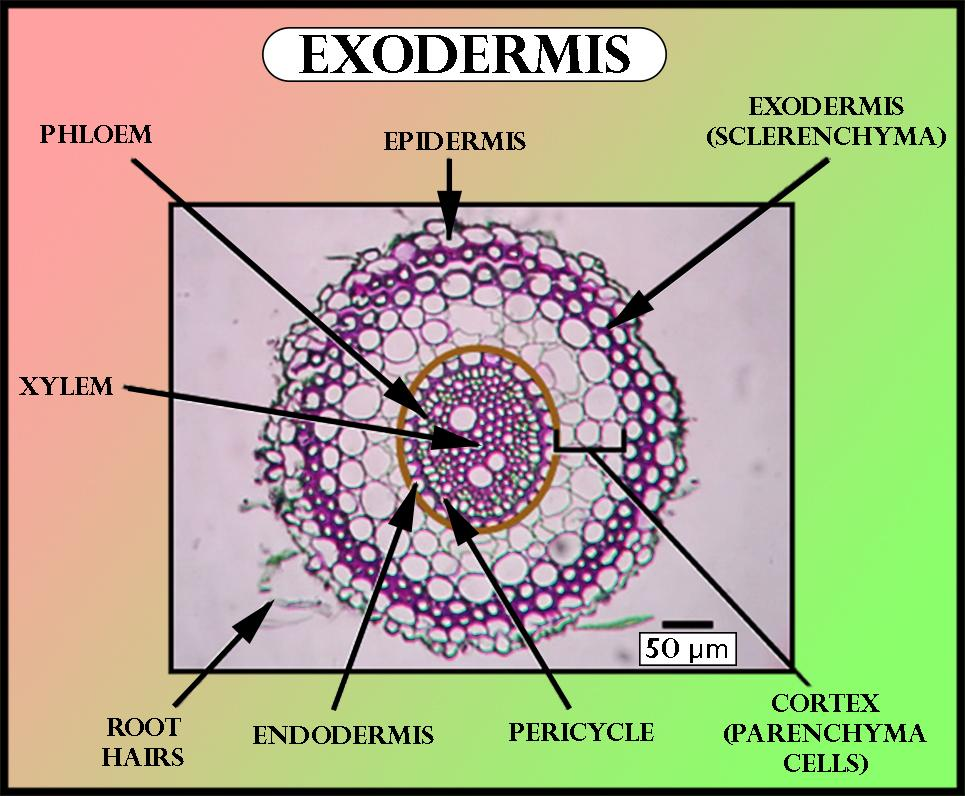
Exodermis occurs in
(a)Monocot root
(b)Dicot root
(c)Leaf
(d)stem
Answer
575.7k+ views
Hint: The exodermis acts as a physiological barrier and has a role in root function and protection. The exodermis is a membrane, which is variable and can adjust according to the soil. It is responsible for the radial flow of water, ions, and nutrients.
Complete answer:
The exodermis occurs in the roots of the monocot plant. After the loss of the epidermis, the external cells of the overall cortex are suberized (with a material called suberin) and become a thick-walled layer called exodermis. The exodermis is the external layer of a plant's cortex, serves a twofold capacity by shielding the root from the intrusion by unfamiliar microbes, and guarantees that the plant doesn’t lose water. The plants can lose water through diffusion, through the root framework and can appropriately renew their stores at a good rate.
Additional Information: -The exodermis is a special type of hypodermis and has Casparian strips in its cell wall, as well as further wall modifications. The strips function to prevent solution backflow into the cortex and to maintain root pressure.
-The Casparian strip is also involved in ensuring that soil is not pulled directly into the root system during the uptake of nutrients.
-The exodermis can modify its permeability in response to a different external stimulus, it can change to better suit the root's requirements.
So, the correct answer is, ’Monocot root.’
Note: Many angiosperms including onion, maize, and sunflower plants have an exodermis layer on the outermost layer of the cortex and the outermost layer of almost all seeded vascular plants. It is not present in seedless vascular plants.

Complete answer:
The exodermis occurs in the roots of the monocot plant. After the loss of the epidermis, the external cells of the overall cortex are suberized (with a material called suberin) and become a thick-walled layer called exodermis. The exodermis is the external layer of a plant's cortex, serves a twofold capacity by shielding the root from the intrusion by unfamiliar microbes, and guarantees that the plant doesn’t lose water. The plants can lose water through diffusion, through the root framework and can appropriately renew their stores at a good rate.
Additional Information: -The exodermis is a special type of hypodermis and has Casparian strips in its cell wall, as well as further wall modifications. The strips function to prevent solution backflow into the cortex and to maintain root pressure.
-The Casparian strip is also involved in ensuring that soil is not pulled directly into the root system during the uptake of nutrients.
-The exodermis can modify its permeability in response to a different external stimulus, it can change to better suit the root's requirements.
So, the correct answer is, ’Monocot root.’
Note: Many angiosperms including onion, maize, and sunflower plants have an exodermis layer on the outermost layer of the cortex and the outermost layer of almost all seeded vascular plants. It is not present in seedless vascular plants.

Recently Updated Pages
Why are manures considered better than fertilizers class 11 biology CBSE

Find the coordinates of the midpoint of the line segment class 11 maths CBSE

Distinguish between static friction limiting friction class 11 physics CBSE

The Chairman of the constituent Assembly was A Jawaharlal class 11 social science CBSE

The first National Commission on Labour NCL submitted class 11 social science CBSE

Number of all subshell of n + l 7 is A 4 B 5 C 6 D class 11 chemistry CBSE

Trending doubts
1 Quintal is equal to a 110 kg b 10 kg c 100kg d 1000 class 11 physics CBSE

What is Environment class 11 chemistry CBSE

Bond order ofO2 O2+ O2 and O22 is in order A O2 langle class 11 chemistry CBSE

How many squares are there in a chess board A 1296 class 11 maths CBSE

Distinguish between verbal and nonverbal communica class 11 english CBSE

The equivalent weight of Mohrs salt FeSO4 NH42SO4 6H2O class 11 chemistry CBSE




